Engineering Thermoplastic Market
Engineering Thermoplastic Market Size and Share Forecast Outlook 2025 to 2035
Engineering thermoplastic market is projected to grow from USD 138.0 billion in 2025 to USD 198.0 billion by 2035, at a CAGR of 3.7%. Polycarbonate will dominate with a 28.0% market share, while automotive will lead the end use segment with a 39.0% share.
Engineering Thermoplastic Market Forecast and Outlook 2025 to 2035
The global engineering thermoplastic market is valued at USD 138.0 billion in 2025. It is slated to reach USD 198.0 billion by 2035, recording an absolute increase of USD 60.0 billion over the forecast period. This translates into a total growth of 43.5%, with the market forecast to expand at a CAGR of 3.7% between 2025 and 2035.
The market is expected to grow by nearly 1.43X during the same period, supported by increasing demand for lightweight and high-performance materials, growing automotive and electronics applications, and rising emphasis on advanced polymer solutions across diverse industrial manufacturing, consumer goods, and technical component systems.
Quick Stats for Engineering Thermoplastic Market
- Engineering Thermoplastic Market Value (2025): USD 138.0 billion
- Engineering Thermoplastic Market Forecast Value (2035): USD 198.0 billion
- Engineering Thermoplastic Market Forecast CAGR: 3.7%
- Leading Type in Engineering Thermoplastic Market: Polycarbonate
- Key Growth Regions in Engineering Thermoplastic Market: Asia Pacific, North America, and Europe
- Key Players in Engineering Thermoplastic Market: BASF, SABIC, Dow, DuPont, Covestro, LG Chem
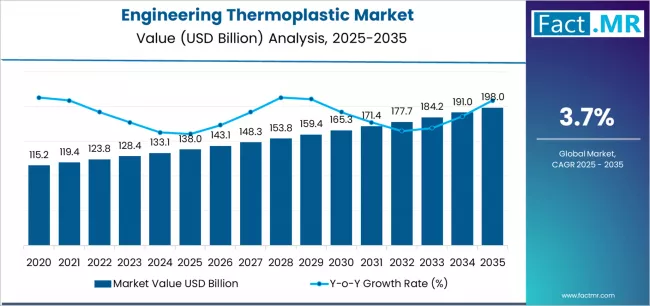
The global engineering thermoplastic market is further fueled by the automotive sector’s shift toward lightweighting and fuel efficiency. Automotive manufacturers are increasingly replacing conventional metals with high-strength thermoplastics in components such as interior panels, under-the-hood parts, electrical housings, and structural elements. This trend is driven by stringent regulatory requirements targeting reduced vehicle emissions and improved energy efficiency, making engineering thermoplastics an essential material for next-generation vehicles, including electric and hybrid models.
Electronics and electrical applications are also emerging as major growth engines. The rise of compact consumer electronics, wearable devices, and sophisticated home appliances has elevated the demand for thermoplastics that combine thermal resistance, dimensional stability, and flame retardancy.
Engineering thermoplastics such as polycarbonate (PC), polybutylene terephthalate (PBT), and polyphenylene sulfide (PPS) are increasingly used in connectors, switches, circuit boards, and enclosures due to their high dielectric properties and resistance to mechanical stress. Additionally, the proliferation of electric vehicles (EVs) is creating significant demand for high-performance polymers in battery housings, insulation systems, and motor components.
Industrial machinery and aerospace sectors are contributing to market growth by adopting thermoplastics for structural and functional applications. Components in robotics, conveyor systems, pumps, and chemical processing units increasingly rely on engineering thermoplastics for corrosion resistance, lightweight design, and long-term durability under extreme conditions.
In aerospace, the substitution of aluminum and titanium parts with high-performance polymers allows for substantial weight reduction without compromising mechanical strength or safety standards, directly contributing to fuel efficiency and operational cost savings.
Geographically, Asia-Pacific is expected to lead the global market, driven by rapid industrialization, growing automotive production, and expanding electronics manufacturing hubs in China, India, Japan, and South Korea. North America and Europe are witnessing steady growth due to technological advancements, stringent environmental regulations, and rising adoption of high-performance polymers in automotive, medical, and electronics applications.
The market’s growth is further supported by innovations in polymer chemistry, including bio-based engineering thermoplastics and recyclable high-performance polymers. Manufacturers are investing in R&D to enhance thermal stability, chemical resistance, and mechanical performance while minimizing environmental impact. As industries increasingly prioritize sustainability, these developments are poised to redefine the competitive landscape, driving both demand and differentiation in the engineering thermoplastic sector. The market is set to experience robust expansion, underpinned by technological innovation, diversified industrial demand, and a growing focus on sustainability and performance-oriented materials.
Between 2025 and 2030, the engineering thermoplastic market is projected to expand from USD 138.0 billion to USD 165.0 billion, resulting in a value increase of USD 27.0 billion, which represents 45.0% of the total forecast growth for the decade.
This phase of development will be shaped by increasing automotive lightweighting initiatives and electronics miniaturization trends, rising demand for sustainable and recyclable materials, and growing applications in advanced manufacturing and precision engineering.
Polymer manufacturers and component producers are expanding their engineering thermoplastic capabilities to address the growing demand for high-performance and versatile material solutions that ensure manufacturing excellence and product innovation optimization.
Engineering Thermoplastic Market Key Takeaways
| Metric | Value |
|---|---|
| Estimated Value in (2025E) | USD 138.0 billion |
| Forecast Value in (2035F) | USD 198.0 billion |
| Forecast CAGR (2025 to 2035) | 3.7% |
From 2030 to 2035, the market is forecast to grow from USD 165.0 billion to USD 198.0 billion, adding another USD 33.0 billion, which constitutes 55.0% of the overall ten-year expansion. This period is expected to be characterized by the expansion of advanced polymer technologies and sustainable material systems, the development of next-generation high-performance formulations, and the growth of specialized applications in electric vehicles and precision electronics manufacturing.
The growing adoption of circular economy practices and advanced manufacturing strategies will drive demand for engineering thermoplastics with enhanced performance characteristics and intelligent processing properties.
Between 2020 and 2025, the engineering thermoplastic market experienced steady growth from USD 116.0 billion to USD 138.0 billion, driven by increasing industrial manufacturing recovery and growing recognition of engineering thermoplastics as essential materials for enhancing product performance and providing comprehensive material solutions in diverse automotive, electronics, and industrial applications.
The market developed as manufacturers and engineers recognized the potential for engineering thermoplastic technology to enhance product reliability, improve manufacturing efficiency, and support lightweighting objectives while meeting performance and regulatory requirements.
Technological advancement in polymer chemistry and processing systems began emphasizing the critical importance of maintaining material performance and sustainability standards in challenging manufacturing environments.
Why is the Engineering Thermoplastic Market Growing?
Market expansion is being supported by the increasing global industrial manufacturing and technological advancement driven by automation trends and material innovation requirements, alongside the corresponding demand for high-performance polymer materials that can enhance product performance, enable lightweight design solutions, and maintain durability standards across various automotive applications, electronics manufacturing, industrial components, and consumer product systems.
Modern manufacturers and product designers are increasingly focused on implementing engineering thermoplastic solutions that can improve product functionality, enhance manufacturing efficiency, and provide consistent performance in demanding application environments.
The growing emphasis on sustainability and material efficiency is driving demand for engineering thermoplastics that can support circular economy initiatives, enable recyclable material systems, and ensure comprehensive environmental effectiveness.
Polymer industry manufacturers' preference for integrated material platforms that combine performance excellence with processing efficiency and environmental sustainability is creating opportunities for innovative engineering thermoplastic implementations.
The rising influence of regulatory compliance requirements and performance optimization is also contributing to increased adoption of engineering thermoplastics that can provide superior material outcomes without compromising manufacturing reliability or environmental standards.
Segmental Analysis
The market is segmented by type, end use, and region. By type, the market is divided into polycarbonate, ABS, nylon, and POM/PET/PBT. Based on end use, the market is categorized into automotive, electrical/electronics, and industrial/others. By region, the market is split between Asia Pacific, North America, and Europe.
By Type, the Polycarbonate Segment Leads the Market
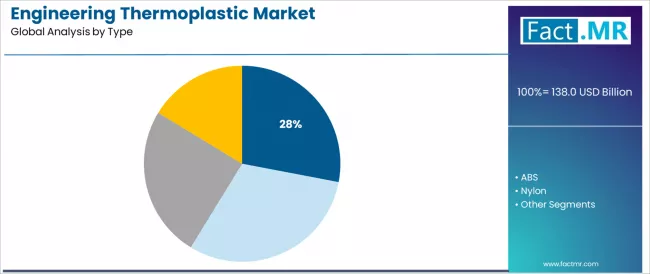
The polycarbonate segment is set to retain its leadership in the engineering thermoplastic market in 2025, accounting for 28.0% of the share. Its continued preference reflects its superior mechanical strength, excellent optical clarity, and proven performance in demanding industrial applications.
Manufacturers and designers increasingly rely on polycarbonate for its ability to deliver high-performance solutions while ensuring processing efficiency and consistent reliability across diverse systems.
Polycarbonate’s versatility and established track record make it foundational to modern engineering materials, providing critical support for applications that demand durability, precision, and performance. Investments in advanced polymer technologies are further reinforcing its adoption, as designers and manufacturers seek materials that meet stringent engineering standards.
With growing demand for high-performance, reliable, and process-efficient solutions, polycarbonate remains a central component of material strategies, bridging engineering objectives with manufacturing excellence across multiple industrial sectors.
By End Use, the Automotive Segment Dominates Market Demand
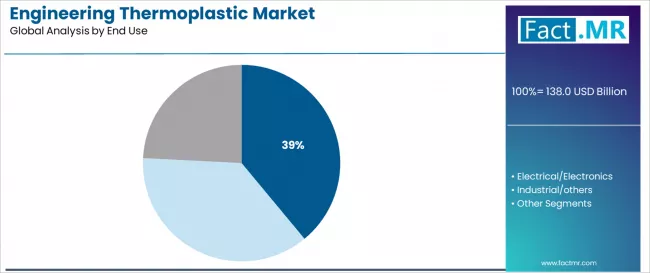
The automotive end-use segment is projected to hold the largest share of engineering thermoplastic applications in 2025, accounting for 39.0% of the market. This highlights its pivotal role as the primary application area for high-performance polymers across vehicle manufacturing, component systems, and automotive engineering operations.
Manufacturers increasingly rely on engineering thermoplastics for their lightweighting benefits, superior performance characteristics, and compatibility with advanced vehicle systems, all while meeting stringent manufacturing standards and regulatory requirements.
Engineering thermoplastics are now essential to automotive engineering, delivering both performance and manufacturing advantages. Continuous innovation in automotive technologies, coupled with integrated vehicle systems, supports enhanced efficiency, optimized manufacturing processes, and improved vehicle performance.
Investments in comprehensive lightweighting programs further drive adoption, helping companies meet fuel efficiency standards and sustainability targets. As automotive performance requirements and engineering standards evolve, the segment is poised to maintain its market dominance while enabling broader utilization of high-performance thermoplastic solutions in vehicle design and manufacturing.
By Region, the Asia Pacific Segment Commands Market Leadership
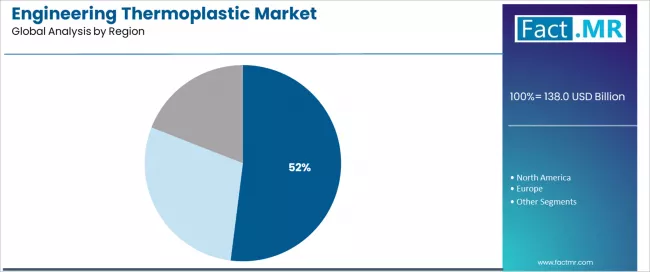
The Asia Pacific region is projected to hold the largest share of engineering thermoplastic demand in 2025, accounting for 52.0% of the market. This underscores the region’s critical role in global manufacturing, industrial growth, and material optimization. Manufacturers in Asia Pacific favor engineering thermoplastics for their ability to support diverse industrial systems with high production efficiency and consistent material performance. The region forms the backbone of engineering thermoplastic demand across multiple manufacturing protocols and industrial applications.
Ongoing technological advancements and the adoption of efficiency-driven operations are fueling the segment’s growth. Rising manufacturing volumes, expanding industrial development, and the need for reliable material solutions continue to drive regional demand. As industrial operations increasingly focus on performance and efficiency, the Asia Pacific segment is set to sustain market leadership while promoting broader adoption of advanced engineering thermoplastics and optimized manufacturing strategies.
What are the Drivers, Restraints, and Key Trends of the Engineering Thermoplastic Market?
The engineering thermoplastic market is advancing steadily due to increasing industrial manufacturing and technological advancement driven by automation trends and material innovation requirements, growing adoption of high-performance polymer technologies that require advanced materials providing enhanced mechanical properties and processing efficiency across diverse automotive applications, electronics manufacturing, industrial components, and consumer product systems.
However, the market faces challenges, including volatile raw material costs and supply chain disruptions, intense competition from alternative materials and metal substitutes, and increasing environmental regulations and sustainability requirements. Innovation in sustainable polymers and advanced processing technologies continues to influence product development and market expansion patterns.
Expansion of Sustainable Materials and Circular Economy Technologies
The growing adoption of sustainable manufacturing approaches is driving demand for eco-friendly polymer materials that address environmental compliance requirements including improved recyclability, enhanced biodegradability, and reduced environmental impact in industrial and consumer applications.
Sustainable polymer applications require advanced engineering thermoplastics that deliver superior environmental performance across multiple application parameters while maintaining reliability and manufacturing effectiveness.
Manufacturers are increasingly recognizing the competitive advantages of sustainable material integration for environmental compliance and market differentiation, creating opportunities for innovative materials specifically designed for next-generation sustainable manufacturing operations.
Integration of Advanced Processing and Manufacturing Technologies
Modern polymer manufacturers are incorporating advanced processing systems and manufacturing optimization technologies to enhance material quality, address technical requirements, and support comprehensive performance objectives through optimized production processes and intelligent quality control.
Leading companies are developing advanced processing platforms, implementing quality monitoring systems, and advancing precision engineering thermoplastics that maximize material effectiveness while supporting predictive manufacturing approaches.
These technologies improve material outcomes while enabling new market opportunities, including high-precision applications, advanced manufacturing, and specialized engineering solutions.
Development of Next-Generation Performance and Functionality Technologies
The expansion of advanced performance systems, functionality enhancement technologies, and intelligent material capabilities is driving demand for engineering thermoplastics with enhanced mechanical performance and specialized application capabilities.
These advanced applications require specialized polymer platforms with precise performance control and exceptional manufacturing reliability that exceed traditional material requirements, creating premium market segments with differentiated performance propositions.
Manufacturers are investing in advanced performance capabilities and functionality development to serve emerging industrial applications while supporting innovation in advanced engineering materials and smart manufacturing sectors.
Analysis of the Engineering Thermoplastic Market by Key Countries
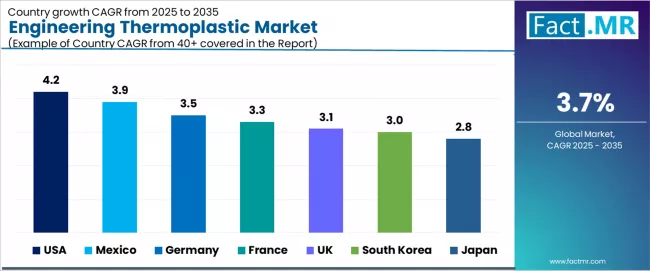
| Country | CAGR (2025-2035) |
|---|---|
| USA | 4.2% |
| Mexico | 3.9% |
| Germany | 3.5% |
| France | 3.3% |
| UK | 3.1% |
| South Korea | 3.0% |
| Japan | 2.8% |
The global engineering thermoplastics market is experiencing steady growth, led by the United States at a 4.2% CAGR through 2035, driven by expanding manufacturing infrastructure, rising demand for advanced materials, and increased investments in automotive, electronics, and industrial innovation initiatives.
Mexico follows with a 3.9% CAGR, supported by manufacturing modernization programs, industrial development, and growing demand for engineering materials in both domestic and export markets.
Germany is forecasted to expand at a 3.5% CAGR, underpinned by materials innovation, automotive sector excellence, and advanced polymer development. France grows at 3.3%, driven by industrial system advancements and the adoption of polymer technologies, while the UK will post a CAG of 3.1%, focusing on materials innovation and advanced manufacturing initiatives.
South Korea is set to achieve a 3.0% CAGR, emphasizing manufacturing modernization and polymer applications, whereas Japan grows at 2.8%, reflecting the country’s focus on stringent quality standards and specialized materials applications.
The report covers an in-depth analysis of 40+ countries; seven top-performing countries are highlighted below.
USA Leads Global Market Growth with Manufacturing Infrastructure and Technology Advancement
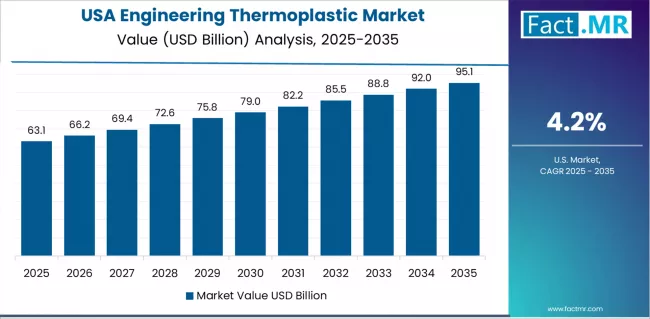
The engineering thermoplastics landscape in the USA is projected to exhibit strong growth with a CAGR of 4.2% through 2035, driven by expanding manufacturing infrastructure and rapidly growing advanced materials sector supported by increasing industrial production and automotive innovation.
The country's substantial industrial system and increasing investment in polymer technologies are creating substantial demand for engineering thermoplastic solutions. Major polymer manufacturers and industrial companies are establishing comprehensive material capabilities to serve both domestic markets and export opportunities.
- Strong manufacturing expansion and growing advanced material requirements are driving demand for engineering thermoplastics throughout major industrial regions including Midwest manufacturing belt, Southeast industrial corridor, and West Coast technology centers, supporting both automotive and electronics applications.
- Growing industrial innovation and advanced manufacturing initiatives are supporting the rapid adoption of engineering thermoplastic technologies among manufacturers seeking enhanced material capabilities and performance excellence in competitive industrial markets.
Mexico Demonstrates Manufacturing Integration with Industrial Development
The engineering thermoplastic market in Mexico is expanding at a CAGR of 3.9%, supported by manufacturing modernization initiatives, growing industrial development, and strategic position as a manufacturing hub for North American markets.
Mexico's industrial development and polymer technology advancement are driving sophisticated engineering thermoplastic capabilities throughout manufacturing sectors. Leading manufacturers and polymer companies are establishing extensive production facilities to address growing domestic manufacturing and export market demand.
- Manufacturing modernization and expanding industrial development are creating opportunities for engineering thermoplastic adoption across manufacturing plants, automotive facilities, and industrial operations in major manufacturing regions including northern Mexico and central manufacturing zones.
- Growing manufacturing sector and polymer technology expansion are supporting the adoption of advanced materials technologies among manufacturers seeking to serve both domestic and international markets while maintaining quality standards and production effectiveness.
Germany Demonstrates Materials Excellence with Automotive Innovation
Germany is likely to progress at a CAGR of 3.5%, driven by the country's materials technology leadership, automotive innovation capabilities, and precision manufacturing excellence supporting high-performance engineering thermoplastic applications.
Germany's industrial expertise and polymer technology innovation are driving demand for specialized engineering thermoplastic solutions throughout manufacturing sectors. Leading materials manufacturers and industrial producers are establishing comprehensive innovation programs for next-generation materials technologies.
- Advanced materials technology development and automotive innovation requirements are creating demand for specialized engineering thermoplastics among manufacturers and automotive companies seeking enhanced material performance and reliability in competitive European markets.
- Strong industrial expertise and materials technology leadership are supporting the adoption of advanced engineering thermoplastic technologies and manufacturing optimization across industrial facilities throughout major manufacturing regions including Bavaria and Baden-Württemberg.
France Shows Industrial Excellence and Materials Technology Innovation Leadership
The market in France is expanding at a CAGR of 3.3%, supported by the country's industrial system excellence, materials technology innovation leadership, and pioneering manufacturing advancement initiatives including sustainable materials and precision engineering development.
France's industrial heritage and materials expertise are supporting investment in advanced engineering thermoplastic technologies. Major manufacturers and materials technology companies are establishing comprehensive development programs incorporating engineering thermoplastic advancement and industrial innovation.
- Advanced industrial innovation and materials technology capabilities are creating demand for premium engineering thermoplastic products supporting industrial excellence, materials advancement, and manufacturing optimization throughout major industrial and technology regions.
- Strong industrial focus and materials technology leadership are driving the adoption of advanced materials technologies and manufacturing enhancement throughout industrial facilities across industrial excellence clusters and innovation zones.
UK Focuses on Materials Innovation and Manufacturing Technology Development
The UK engineering thermoplastic market is growing at a CAGR of 3.1%, driven by the country's materials innovation, manufacturing technology development initiatives, and emphasis on advanced industrial solutions for automotive and electronics applications.
The UK's materials research excellence and manufacturing commitments are supporting investment in advanced engineering thermoplastic technologies. Major manufacturers and materials technology companies are establishing comprehensive development programs incorporating advanced engineering thermoplastic configurations.
- Materials innovation and manufacturing development requirements are creating demand for high-performance engineering thermoplastics supporting industrial advancement, materials innovation, and manufacturing optimization throughout major industrial and technology regions.
- Strong research capabilities and industrial mandates are driving the adoption of advanced materials technologies and manufacturing enhancement supporting superior industrial performance and materials leadership in competitive global markets.
South Korea Demonstrates Manufacturing Leadership with Materials Technology Focus
Revenue from the engineering thermoplastics market in South Korea is expanding at a CAGR of 3.0%, supported by the country's manufacturing modernization, materials technology expertise, and strong emphasis on advanced materials solutions for comprehensive automotive and electronics applications.
South Korea's manufacturing sophistication and materials innovation focus are driving sophisticated engineering thermoplastic capabilities throughout industrial sectors. Leading manufacturers and materials technology companies are investing extensively in advanced materials technologies.
- Advanced manufacturing development and materials technology innovation are creating demand for specialized engineering thermoplastic products throughout manufacturing applications, materials systems, and production facilities in major industrial regions including Seoul Capital Area and manufacturing innovation zones.
- Strong manufacturing industry and materials expertise are supporting the adoption of innovative materials technologies and manufacturing optimization for next-generation applications requiring superior material performance and manufacturing excellence.
Japan Shows Quality Excellence Focus with Specialized Materials Applications
The engineering thermoplastic ecosystem in Japan is expanding at a CAGR of 2.8%, supported by the country's quality excellence standards, specialized manufacturing capabilities, and strong emphasis on high-specification materials technologies for advanced automotive and electronics sectors.
Japan's quality sophistication and manufacturing excellence are driving demand for premium engineering thermoplastic products. Leading manufacturers and materials technology companies are investing in specialized capabilities for advanced materials applications.
- Advanced materials processing and quality manufacturing requirements are creating opportunities for high-quality engineering thermoplastic products throughout specialized manufacturing production, materials manufacturing, and industrial applications meeting stringent quality and performance standards.
- Strong manufacturing industry and materials sector are driving adoption of specialized engineering thermoplastic devices and advanced materials technologies supporting innovation in manufacturing operations, materials advancement, and industrial sectors requiring superior material performance and consistency.
Europe Market Split by Country
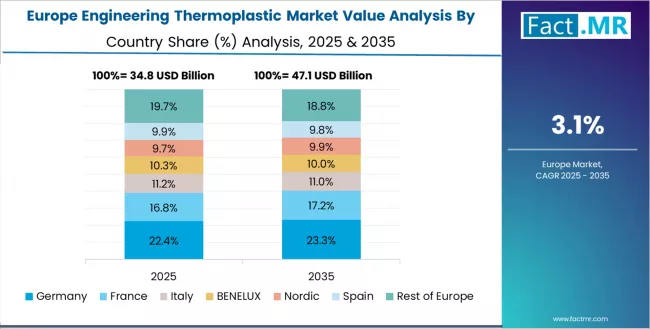
The European engineering thermoplastics market is projected to grow from USD 27.6 billion in 2025 to USD 39.6 billion by 2035, registering a CAGR of 3.7% over the forecast period. Germany is expected to retain its leadership, accounting for 23.9% of the market in 2025 and slightly moderating to 23.5% by 2035, supported by its advanced materials technology sector and automotive innovation capabilities.
France follows with an 18.8% share in 2025, projected to increase to 19.1% by 2035, driven by comprehensive industrial development and application of advanced materials technologies. The United Kingdom holds a 16.9% share in 2025, expected to decline modestly to 16.6% by 2035 amid market diversifications. Italy commands 11.2%, while Spain represents 7.8% of the market in 2025.
The Rest of Europe is anticipated to gain momentum, expanding its collective share from 21.4% in 2025 to 22.0% by 2035, supported by rising adoption of materials technologies in Nordic countries and the emergence of advanced manufacturing systems across Eastern Europe.
Polycarbonate Applications Dominate Industrial Operations in Japan
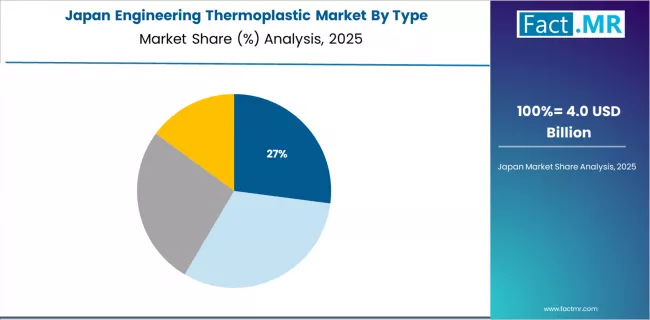
The engineering thermoplastics market in Japan is characterized by a mature, precision-driven landscape, with advanced integration of polycarbonate and other high-performance thermoplastics into manufacturing infrastructure across industrial facilities, materials networks, and production systems. Japan’s strong focus on quality and manufacturing precision fuels demand for reliable engineering thermoplastic solutions that meet stringent industrial standards and regulatory requirements.
The market benefits from strategic partnerships between global materials providers, such as BASF and SABIC, and domestic manufacturing leaders, including established industrial companies, creating comprehensive service ecosystems that emphasize materials quality and precision-driven manufacturing programs. Key industrial hubs demonstrate advanced engineering thermoplastic applications, where integrated materials systems enhance production efficiency, improve process reliability, and support broader industrial modernization initiatives.
Automotive Applications Lead Materials Services in South Korea
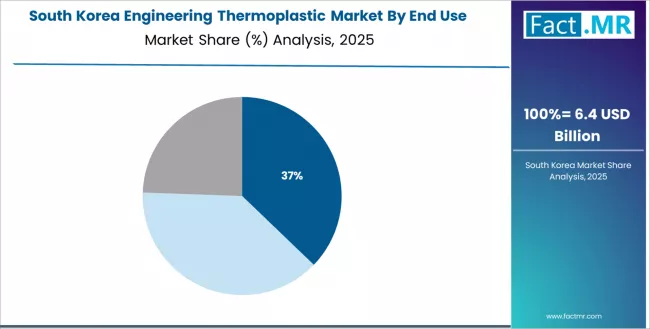
The engineering thermoplastics market in South Korea is strongly driven by the country’s robust automotive sector, with global players such as Dow, DuPont, and Covestro maintaining leading positions through comprehensive system integration and advanced materials services for manufacturing modernization and polymer applications.
The market is increasingly emphasizing localized materials support and rapid deployment capabilities, as Korean manufacturers seek customized solutions that seamlessly integrate with domestic manufacturing infrastructure and advanced materials systems across major industrial hubs. Regional manufacturers and materials integrators are gaining traction through strategic partnerships with multinational suppliers, offering specialized services including materials training programs and certification for manufacturing professionals.
The competitive landscape is marked by growing collaboration between global materials companies and local manufacturing specialists, creating hybrid service models that combine international expertise with deep local market knowledge and strong manufacturing relationship management. This approach enables tailored solutions, faster adoption of advanced materials, and strengthened positioning in South Korea’s evolving industrial and automotive ecosystem.
Competitive Landscape of the Engineering Thermoplastic Market
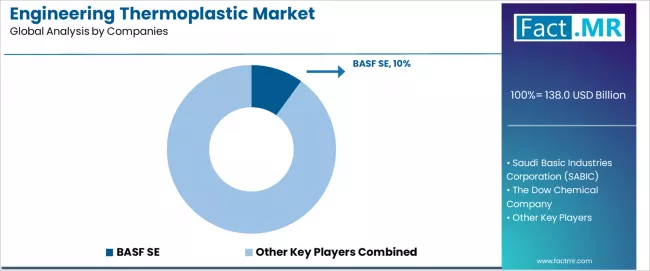
The engineering thermoplastic market is characterized by competition among established polymer manufacturers, specialized engineering materials producers, and diversified chemical companies with industrial focus.
Companies are investing in advanced polymer technology development, sustainability innovation, product portfolio expansion, and application-specific material development to deliver high-performance, cost-effective, and environmentally sustainable engineering thermoplastic solutions. Innovation in sustainable polymers, processing technology integration, and specialized application development is central to strengthening market position and competitive advantage.
BASF leads the market with a 10.0% share, offering comprehensive engineering thermoplastic solutions with a focus on industrial applications, advanced polymer systems, and integrated material platforms across diverse automotive and electronics distribution channels. The company has announced major technology advancement initiatives and investments in sustainable materials and circular economy technologies to support growing global demand for high-performance polymers and efficient manufacturing solutions.
Other key players including SABIC provide innovative polymer solutions with emphasis on materials excellence and sustainability technologies, while Dow delivers specialized chemical solutions with focus on advanced materials and industrial applications.
DuPont offers comprehensive polymer solutions with engineering thermoplastic offerings for multiple industrial categories, and Covestro provides advanced materials technologies with emphasis on high-performance systems and manufacturing optimization. LG Chem, Celanese, Toray, Mitsubishi Chemical, and Teijin contribute to market competition through specialized polymer capabilities and materials expertise.
Engineering Thermoplastic Market - Stakeholder Contribution Framework
Engineering thermoplastics constitute a specialized segment of high-performance materials within industrial and manufacturing applications, projected to grow from USD 138.0 billion in 2025 to USD 198.0 billion by 2035, reflecting a CAGR of 3.7%. Products, including polycarbonate, ABS, nylon, and POM/PET/PBT formulations, serve as essential structural components across manufacturing systems, automotive applications, electronics production, and other industrial sectors where mechanical performance, processing efficiency, and material reliability are critical.
Market growth is fueled by the expansion of industrial manufacturing, rising demand in automotive and electronics sectors, and the development of advanced manufacturing technologies. Increasing requirements for durable, high-performance material solutions across diverse applications are further driving adoption, reinforcing engineering thermoplastics as a cornerstone of modern industrial and manufacturing operations.
How Manufacturing Regulators Could Strengthen Materials Standards and Industrial Safety?
- Materials Standards: Establish comprehensive technical specifications for engineering thermoplastics, including safety requirements, performance standards, material validation protocols, and quality guidelines that ensure consistent performance across manufacturing applications, automotive systems, electronics manufacturing, and industrial operations.
- Industrial Safety Integration: Develop regulatory frameworks that incentivize advanced materials practices, requiring manufacturers to implement quality management systems, utilize material validation protocols, incorporate safety procedures, and achieve measurable performance improvements in engineering thermoplastic development.
- Quality Assurance Requirements: Implement mandatory quality control standards for engineering thermoplastic manufacturing, including material testing protocols, safety verification measures, and performance validation systems that ensure material effectiveness and industrial safety across diverse manufacturing applications.
- Industrial Materials Guidelines: Create specialized regulations for industrial-grade engineering thermoplastics used in critical applications, addressing stringent safety specifications, material requirements, and regulatory validation specific to industrial applications requiring enhanced reliability and safety protection.
- Innovation Support Programs: Provide regulatory facilitation and research incentives for development of next-generation materials technologies that improve industrial performance, enhance safety, and enable emerging applications in sustainable manufacturing and precision industrial systems.
How Industry Associations Could Advance Materials Technology Standards and Market Development?
- Materials Best Practices: Develop comprehensive technical guidelines for engineering thermoplastic selection, material optimization, and performance validation techniques that maximize industrial effectiveness, ensure safety, and maintain cost-effectiveness across manufacturing applications, automotive systems, and materials processing operations.
- Manufacturing Benchmarking: Establish industry-wide metrics for materials performance, including industrial assessment, performance measurement, manufacturing outcome evaluation, and materials documentation that enable comparative analysis and drive continuous improvement toward materials optimization objectives.
- Professional Training Programs: Create specialized education initiatives for materials technicians, manufacturing operators, and industrial professionals covering engineering thermoplastic characteristics, materials applications, safety requirements, and technical procedures across diverse manufacturing applications.
- Materials Standardization: Develop standardized testing methodologies for engineering thermoplastic evaluation, including performance assessment, materials analysis, manufacturing validation, and application-specific performance metrics that facilitate objective material comparison and manufacturing validation.
- Materials Collaboration: Facilitate partnerships between engineering thermoplastic suppliers, manufacturers, research institutions, and industry organizations to advance materials technology development, address emerging manufacturing challenges, and accelerate innovation in industrial and automotive applications.
How Engineering Thermoplastic Manufacturers Could Drive Innovation and Market Leadership?
- Advanced Materials Technologies: Invest in polymer system enhancement, manufacturing optimization, processing integration, and performance improvement initiatives that enhance materials effectiveness while maintaining reliability and regulatory compliance in global markets.
- Specialized Material Development: Develop specialized engineering thermoplastics with enhanced manufacturing characteristics, including optimized mechanical properties, improved processing performance, increased manufacturing efficiency, and application-specific attributes for emerging industrial segments.
- Materials Quality Integration: Implement intelligent quality control systems with real-time performance monitoring, predictive materials assessment, automated manufacturing verification, and data analytics that optimize material performance, ensure manufacturing reliability, and reduce processing complexity.
- Materials Support Services: Establish comprehensive customer service capabilities providing technical consultation, training assistance, materials troubleshooting, and manufacturing expertise that strengthen customer relationships and enable successful industrial implementation.
- Global Materials Excellence: Develop regional service networks, specialized materials support management, reliable technical support systems, and responsive customer service that ensure consistent material availability, maintain materials quality, and support customer manufacturing requirements worldwide.
How End-User Industries Could Optimize Materials Performance and Manufacturing Success?
- Strategic Material Selection: Conduct comprehensive assessments of manufacturing requirements, materials needs, regulatory constraints, and operational considerations to optimize engineering thermoplastic selection and achieve desired materials characteristics while managing total manufacturing costs and performance outcomes.
- Materials Workflow Optimization: Implement advanced materials methodologies utilizing performance validation, outcome evaluation, and systematic manufacturing assessment to maximize engineering thermoplastic materials benefits, minimize processing complexity, and optimize overall manufacturing effectiveness and materials satisfaction.
- Manufacturing Management: Develop optimized materials protocols, manufacturing control procedures, and outcome validation that ensure effective engineering thermoplastic utilization, maximize materials benefits, and maintain consistent manufacturing performance throughout materials operations.
- Quality Materials Integration: Incorporate materials best practices, manufacturing principles, and materials quality considerations into materials planning and manufacturing processes that support comprehensive manufacturing objectives and materials excellence.
- Strategic Materials Partnerships: Establish strategic partnerships with engineering thermoplastic suppliers for joint materials programs, manufacturing optimization initiatives, and co-innovation projects that address specific manufacturing challenges and accelerate materials technology commercialization.
How Research Institutions Could Enable Materials Technology Advancement?
- Materials Research Programs: Conduct fundamental investigations into engineering thermoplastic technology, materials mechanisms, manufacturing optimization, and industrial applications that advance materials understanding and enable breakthrough innovations in materials technology and manufacturing science.
- Materials Technology Development: Develop novel materials methods, including advanced polymer techniques, manufacturing approaches, and performance enhancement technologies that improve materials performance while maintaining manufacturing effectiveness and cost efficiency.
- Manufacturing Application Innovation: Investigate emerging applications for engineering thermoplastics in precision manufacturing, advanced industrial systems, sustainable operations, and specialized manufacturing applications that create new market opportunities and expand materials potential.
- Materials Validation Services: Provide advanced materials research services utilizing performance validation, materials testing, manufacturing assessment, and operational evaluation methodologies that enable detailed understanding of engineering thermoplastic properties and manufacturing applications.
- Materials Technology Transfer: Facilitate technology commercialization through licensing agreements, startup incubation programs, materials publications, and collaborative research projects that accelerate materials technology innovation adoption and strengthen industry-academia partnerships.
How Investors and Financial Enablers Could Support Materials Technology Market Growth?
- Materials Infrastructure Investment: Provide capital for engineering thermoplastic manufacturing facility construction, production capacity expansion, and technology upgrade projects that address growing manufacturing demand while improving materials efficiency and performance.
- Materials Innovation Financing: Fund research and development of breakthrough engineering thermoplastic technologies, including advanced materials methods, manufacturing systems, and novel industrial applications that address current market limitations and create competitive advantages.
- Manufacturing Development Support: Finance materials technology innovation initiatives, manufacturing validation programs, regulatory development, and materials advancement that enhance materials capabilities and position manufacturers for long-term market acceptance and growth.
- Industrial Market Expansion: Support strategic acquisitions, market entry initiatives, distribution network development, and customer materials service capabilities that accelerate geographic expansion and strengthen competitive positions in high-growth manufacturing markets.
- Global Materials Development: Provide financing and technical assistance for engineering thermoplastic facilities in developing economies, creating new materials technology supply capabilities, supporting local manufacturing development, and expanding global market access for materials solutions.
Key Players in the Engineering Thermoplastic Market
- BASF SE
- Saudi Basic Industries Corporation (SABIC)
- The Dow Chemical Company
- DuPont de Nemours, Inc.
- Covestro AG
- LG Chem, Ltd.
- Celanese Corporation
- Toray Industries, Inc.
- Mitsubishi Chemical Corporation
- Teijin Limited
Scope of the Report
| Items | Values |
|---|---|
| Quantitative Units (2025) | USD 138.0 Billion |
| Type | Polycarbonate, ABS, Nylon, POM/PET/PBT |
| End Use | Automotive, Electrical/Electronics, Industrial/others |
| Region | Asia Pacific, North America, Europe |
| Regions Covered | North America, Europe, Asia Pacific, Latin America, Middle East & Africa |
| Countries Covered | USA, Germany, France, UK, Japan, South Korea, Mexico, and 40+ countries |
| Key Companies Profiled | BASF, SABIC, Dow, DuPont, Covestro, LG Chem |
| Additional Attributes | Dollar sales by type and end use category, regional demand trends, competitive landscape, technological advancements in materials production, polymer development, manufacturing innovation, and performance optimization |
Engineering Thermoplastic Market by Segments
-
Type :
- Polycarbonate
- ABS
- Nylon
- POM/PET/PBT
-
End Use :
- Automotive
- Electrical/Electronics
- Industrial/others
-
Region :
- Asia Pacific
- North America
- Europe
-
Detailed Regional Breakdown :
-
North America
- United States
- Canada
- Mexico
-
Europe
- Germany
- United Kingdom
- France
- Italy
- Spain
- Netherlands
- Nordic
- BENELUX
- Rest of Europe
-
Asia Pacific
- China
- Japan
- South Korea
- Taiwan
- Australia
- Rest of Asia Pacific
-
Latin America
- Brazil
- Argentina
- Chile
- Rest of Latin America
-
Middle East & Africa
- Kingdom of Saudi Arabia
- Other GCC Countries
- Turkey
- South Africa
- Other African Union
- Rest of Middle East & Africa
-
Eastern Europe
- Russia
- Poland
- Czech Republic
- Rest of Eastern Europe
-
Table of Content
- Executive Summary
- Global Market Outlook
- Demand to side Trends
- Supply to side Trends
- Technology Roadmap Analysis
- Analysis and Recommendations
- Market Overview
- Market Coverage / Taxonomy
- Market Definition / Scope / Limitations
- Market Background
- Market Dynamics
- Drivers
- Restraints
- Opportunity
- Trends
- Scenario Forecast
- Demand in Optimistic Scenario
- Demand in Likely Scenario
- Demand in Conservative Scenario
- Opportunity Map Analysis
- Product Life Cycle Analysis
- Supply Chain Analysis
- Investment Feasibility Matrix
- Value Chain Analysis
- PESTLE and Porter’s Analysis
- Regulatory Landscape
- Regional Parent Market Outlook
- Production and Consumption Statistics
- Import and Export Statistics
- Market Dynamics
- Global Market Analysis 2020 to 2024 and Forecast, 2025 to 2035
- Historical Market Size Value (USD Million) Analysis, 2020 to 2024
- Current and Future Market Size Value (USD Million) Projections, 2025 to 2035
- Y to o to Y Growth Trend Analysis
- Absolute $ Opportunity Analysis
- Global Market Pricing Analysis 2020 to 2024 and Forecast 2025 to 2035
- Global Market Analysis 2020 to 2024 and Forecast 2025 to 2035, By Type
- Introduction / Key Findings
- Historical Market Size Value (USD Million) Analysis By Type , 2020 to 2024
- Current and Future Market Size Value (USD Million) Analysis and Forecast By Type , 2025 to 2035
- Polycarbonate
- ABS
- Nylon
- POM/PET/PBT
- Y to o to Y Growth Trend Analysis By Type , 2020 to 2024
- Absolute $ Opportunity Analysis By Type , 2025 to 2035
- Global Market Analysis 2020 to 2024 and Forecast 2025 to 2035, By End Use
- Introduction / Key Findings
- Historical Market Size Value (USD Million) Analysis By End Use, 2020 to 2024
- Current and Future Market Size Value (USD Million) Analysis and Forecast By End Use, 2025 to 2035
- Automotive
- Electrical/Electronics
- Industrial/others
- Y to o to Y Growth Trend Analysis By End Use, 2020 to 2024
- Absolute $ Opportunity Analysis By End Use, 2025 to 2035
- Global Market Analysis 2020 to 2024 and Forecast 2025 to 2035, By Region
- Introduction / Key Findings
- Historical Market Size Value (USD Million) Analysis By Region, 2020 to 2024
- Current and Future Market Size Value (USD Million) Analysis and Forecast By Region, 2025 to 2035
- Asia Pacific
- North America
- Europe
- Y to o to Y Growth Trend Analysis By Region, 2020 to 2024
- Absolute $ Opportunity Analysis By Region, 2025 to 2035
- Global Market Analysis 2020 to 2024 and Forecast 2025 to 2035, By Region
- Introduction
- Historical Market Size Value (USD Million) Analysis By Region, 2020 to 2024
- Current Market Size Value (USD Million) Analysis and Forecast By Region, 2025 to 2035
- North America
- Latin America
- Western Europe
- Eastern Europe
- East Asia
- South Asia and Pacific
- Middle East & Africa
- Market Attractiveness Analysis By Region
- North America Market Analysis 2020 to 2024 and Forecast 2025 to 2035, By Country
- Historical Market Size Value (USD Million) Trend Analysis By Market Taxonomy, 2020 to 2024
- Market Size Value (USD Million) Forecast By Market Taxonomy, 2025 to 2035
- By Country
- USA
- Canada
- Mexico
- By Type
- By End Use
- By Region
- By Country
- Market Attractiveness Analysis
- By Country
- By Type
- By End Use
- By Region
- Key Takeaways
- Latin America Market Analysis 2020 to 2024 and Forecast 2025 to 2035, By Country
- Historical Market Size Value (USD Million) Trend Analysis By Market Taxonomy, 2020 to 2024
- Market Size Value (USD Million) Forecast By Market Taxonomy, 2025 to 2035
- By Country
- Brazil
- Chile
- Rest of Latin America
- By Type
- By End Use
- By Region
- By Country
- Market Attractiveness Analysis
- By Country
- By Type
- By End Use
- By Region
- Key Takeaways
- Western Europe Market Analysis 2020 to 2024 and Forecast 2025 to 2035, By Country
- Historical Market Size Value (USD Million) Trend Analysis By Market Taxonomy, 2020 to 2024
- Market Size Value (USD Million) Forecast By Market Taxonomy, 2025 to 2035
- By Country
- Germany
- UK
- Italy
- Spain
- France
- Nordic
- BENELUX
- Rest of Western Europe
- By Type
- By End Use
- By Region
- By Country
- Market Attractiveness Analysis
- By Country
- By Type
- By End Use
- By Region
- Key Takeaways
- Eastern Europe Market Analysis 2020 to 2024 and Forecast 2025 to 2035, By Country
- Historical Market Size Value (USD Million) Trend Analysis By Market Taxonomy, 2020 to 2024
- Market Size Value (USD Million) Forecast By Market Taxonomy, 2025 to 2035
- By Country
- Russia
- Poland
- Hungary
- Balkan & Baltic
- Rest of Eastern Europe
- By Type
- By End Use
- By Region
- By Country
- Market Attractiveness Analysis
- By Country
- By Type
- By End Use
- By Region
- Key Takeaways
- East Asia Market Analysis 2020 to 2024 and Forecast 2025 to 2035, By Country
- Historical Market Size Value (USD Million) Trend Analysis By Market Taxonomy, 2020 to 2024
- Market Size Value (USD Million) Forecast By Market Taxonomy, 2025 to 2035
- By Country
- China
- Japan
- South Korea
- By Type
- By End Use
- By Region
- By Country
- Market Attractiveness Analysis
- By Country
- By Type
- By End Use
- By Region
- Key Takeaways
- South Asia and Pacific Market Analysis 2020 to 2024 and Forecast 2025 to 2035, By Country
- Historical Market Size Value (USD Million) Trend Analysis By Market Taxonomy, 2020 to 2024
- Market Size Value (USD Million) Forecast By Market Taxonomy, 2025 to 2035
- By Country
- India
- ASEAN
- Australia & New Zealand
- Rest of South Asia and Pacific
- By Type
- By End Use
- By Region
- By Country
- Market Attractiveness Analysis
- By Country
- By Type
- By End Use
- By Region
- Key Takeaways
- Middle East & Africa Market Analysis 2020 to 2024 and Forecast 2025 to 2035, By Country
- Historical Market Size Value (USD Million) Trend Analysis By Market Taxonomy, 2020 to 2024
- Market Size Value (USD Million) Forecast By Market Taxonomy, 2025 to 2035
- By Country
- Kingdom of Saudi Arabia
- Other GCC Countries
- Turkiye
- South Africa
- Other African Union
- Rest of Middle East & Africa
- By Type
- By End Use
- By Region
- By Country
- Market Attractiveness Analysis
- By Country
- By Type
- By End Use
- By Region
- Key Takeaways
- Key Countries Market Analysis
- USA
- Pricing Analysis
- Market Share Analysis, 2024
- By Type
- By End Use
- By Region
- Canada
- Pricing Analysis
- Market Share Analysis, 2024
- By Type
- By End Use
- By Region
- Mexico
- Pricing Analysis
- Market Share Analysis, 2024
- By Type
- By End Use
- By Region
- Brazil
- Pricing Analysis
- Market Share Analysis, 2024
- By Type
- By End Use
- By Region
- Chile
- Pricing Analysis
- Market Share Analysis, 2024
- By Type
- By End Use
- By Region
- Germany
- Pricing Analysis
- Market Share Analysis, 2024
- By Type
- By End Use
- By Region
- UK
- Pricing Analysis
- Market Share Analysis, 2024
- By Type
- By End Use
- By Region
- Italy
- Pricing Analysis
- Market Share Analysis, 2024
- By Type
- By End Use
- By Region
- Spain
- Pricing Analysis
- Market Share Analysis, 2024
- By Type
- By End Use
- By Region
- France
- Pricing Analysis
- Market Share Analysis, 2024
- By Type
- By End Use
- By Region
- India
- Pricing Analysis
- Market Share Analysis, 2024
- By Type
- By End Use
- By Region
- ASEAN
- Pricing Analysis
- Market Share Analysis, 2024
- By Type
- By End Use
- By Region
- Australia & New Zealand
- Pricing Analysis
- Market Share Analysis, 2024
- By Type
- By End Use
- By Region
- China
- Pricing Analysis
- Market Share Analysis, 2024
- By Type
- By End Use
- By Region
- Japan
- Pricing Analysis
- Market Share Analysis, 2024
- By Type
- By End Use
- By Region
- South Korea
- Pricing Analysis
- Market Share Analysis, 2024
- By Type
- By End Use
- By Region
- Russia
- Pricing Analysis
- Market Share Analysis, 2024
- By Type
- By End Use
- By Region
- Poland
- Pricing Analysis
- Market Share Analysis, 2024
- By Type
- By End Use
- By Region
- Hungary
- Pricing Analysis
- Market Share Analysis, 2024
- By Type
- By End Use
- By Region
- Kingdom of Saudi Arabia
- Pricing Analysis
- Market Share Analysis, 2024
- By Type
- By End Use
- By Region
- Turkiye
- Pricing Analysis
- Market Share Analysis, 2024
- By Type
- By End Use
- By Region
- South Africa
- Pricing Analysis
- Market Share Analysis, 2024
- By Type
- By End Use
- By Region
- USA
- Market Structure Analysis
- Competition Dashboard
- Competition Benchmarking
- Market Share Analysis of Top Players
- By Regional
- By Type
- By End Use
- By Region
- Competition Analysis
- Competition Deep Dive
- BASF SE
- Overview
- Product Portfolio
- Profitability by Market Segments (Product/Age /Sales Channel/Region)
- Sales Footprint
- Strategy Overview
- Marketing Strategy
- Product Strategy
- Channel Strategy
- Saudi Basic Industries Corporation (SABIC)
- The Dow Chemical Company
- DuPont de Nemours, Inc.
- Covestro AG
- LG Chem, Ltd.
- Celanese Corporation
- Toray Industries, Inc.
- Mitsubishi Chemical Corporation
- Teijin Limited
- BASF SE
- Competition Deep Dive
- Assumptions & Acronyms Used
- Research Methodology
List Of Table
- Table 1: Global Market Value (USD Million) Forecast by Region, 2020 to 2035
- Table 2: Global Market Value (USD Million) Forecast by Type , 2020 to 2035
- Table 3: Global Market Value (USD Million) Forecast by End Use, 2020 to 2035
- Table 4: Global Market Value (USD Million) Forecast by Region, 2020 to 2035
- Table 5: North America Market Value (USD Million) Forecast by Country, 2020 to 2035
- Table 6: North America Market Value (USD Million) Forecast by Type , 2020 to 2035
- Table 7: North America Market Value (USD Million) Forecast by End Use, 2020 to 2035
- Table 8: North America Market Value (USD Million) Forecast by Region, 2020 to 2035
- Table 9: Latin America Market Value (USD Million) Forecast by Country, 2020 to 2035
- Table 10: Latin America Market Value (USD Million) Forecast by Type , 2020 to 2035
- Table 11: Latin America Market Value (USD Million) Forecast by End Use, 2020 to 2035
- Table 12: Latin America Market Value (USD Million) Forecast by Region, 2020 to 2035
- Table 13: Western Europe Market Value (USD Million) Forecast by Country, 2020 to 2035
- Table 14: Western Europe Market Value (USD Million) Forecast by Type , 2020 to 2035
- Table 15: Western Europe Market Value (USD Million) Forecast by End Use, 2020 to 2035
- Table 16: Western Europe Market Value (USD Million) Forecast by Region, 2020 to 2035
- Table 17: Eastern Europe Market Value (USD Million) Forecast by Country, 2020 to 2035
- Table 18: Eastern Europe Market Value (USD Million) Forecast by Type , 2020 to 2035
- Table 19: Eastern Europe Market Value (USD Million) Forecast by End Use, 2020 to 2035
- Table 20: Eastern Europe Market Value (USD Million) Forecast by Region, 2020 to 2035
- Table 21: East Asia Market Value (USD Million) Forecast by Country, 2020 to 2035
- Table 22: East Asia Market Value (USD Million) Forecast by Type , 2020 to 2035
- Table 23: East Asia Market Value (USD Million) Forecast by End Use, 2020 to 2035
- Table 24: East Asia Market Value (USD Million) Forecast by Region, 2020 to 2035
- Table 25: South Asia and Pacific Market Value (USD Million) Forecast by Country, 2020 to 2035
- Table 26: South Asia and Pacific Market Value (USD Million) Forecast by Type , 2020 to 2035
- Table 27: South Asia and Pacific Market Value (USD Million) Forecast by End Use, 2020 to 2035
- Table 28: South Asia and Pacific Market Value (USD Million) Forecast by Region, 2020 to 2035
- Table 29: Middle East & Africa Market Value (USD Million) Forecast by Country, 2020 to 2035
- Table 30: Middle East & Africa Market Value (USD Million) Forecast by Type , 2020 to 2035
- Table 31: Middle East & Africa Market Value (USD Million) Forecast by End Use, 2020 to 2035
- Table 32: Middle East & Africa Market Value (USD Million) Forecast by Region, 2020 to 2035
List Of Figures
- Figure 1: Global Market Pricing Analysis
- Figure 2: Global Market Value (USD Million) Forecast 2020-2035
- Figure 3: Global Market Value Share and BPS Analysis by Type , 2025 and 2035
- Figure 4: Global Market Y to o to Y Growth Comparison by Type , 2025-2035
- Figure 5: Global Market Attractiveness Analysis by Type
- Figure 6: Global Market Value Share and BPS Analysis by End Use, 2025 and 2035
- Figure 7: Global Market Y to o to Y Growth Comparison by End Use, 2025-2035
- Figure 8: Global Market Attractiveness Analysis by End Use
- Figure 9: Global Market Value Share and BPS Analysis by Region, 2025 and 2035
- Figure 10: Global Market Y to o to Y Growth Comparison by Region, 2025-2035
- Figure 11: Global Market Attractiveness Analysis by Region
- Figure 12: Global Market Value (USD Million) Share and BPS Analysis by Region, 2025 and 2035
- Figure 13: Global Market Y to o to Y Growth Comparison by Region, 2025-2035
- Figure 14: Global Market Attractiveness Analysis by Region
- Figure 15: North America Market Incremental Dollar Opportunity, 2025-2035
- Figure 16: Latin America Market Incremental Dollar Opportunity, 2025-2035
- Figure 17: Western Europe Market Incremental Dollar Opportunity, 2025-2035
- Figure 18: Eastern Europe Market Incremental Dollar Opportunity, 2025-2035
- Figure 19: East Asia Market Incremental Dollar Opportunity, 2025-2035
- Figure 20: South Asia and Pacific Market Incremental Dollar Opportunity, 2025-2035
- Figure 21: Middle East & Africa Market Incremental Dollar Opportunity, 2025-2035
- Figure 22: North America Market Value Share and BPS Analysis by Country, 2025 and 2035
- Figure 23: North America Market Value Share and BPS Analysis by Type , 2025 and 2035
- Figure 24: North America Market Y to o to Y Growth Comparison by Type , 2025-2035
- Figure 25: North America Market Attractiveness Analysis by Type
- Figure 26: North America Market Value Share and BPS Analysis by End Use, 2025 and 2035
- Figure 27: North America Market Y to o to Y Growth Comparison by End Use, 2025-2035
- Figure 28: North America Market Attractiveness Analysis by End Use
- Figure 29: North America Market Value Share and BPS Analysis by Region, 2025 and 2035
- Figure 30: North America Market Y to o to Y Growth Comparison by Region, 2025-2035
- Figure 31: North America Market Attractiveness Analysis by Region
- Figure 32: Latin America Market Value Share and BPS Analysis by Country, 2025 and 2035
- Figure 33: Latin America Market Value Share and BPS Analysis by Type , 2025 and 2035
- Figure 34: Latin America Market Y to o to Y Growth Comparison by Type , 2025-2035
- Figure 35: Latin America Market Attractiveness Analysis by Type
- Figure 36: Latin America Market Value Share and BPS Analysis by End Use, 2025 and 2035
- Figure 37: Latin America Market Y to o to Y Growth Comparison by End Use, 2025-2035
- Figure 38: Latin America Market Attractiveness Analysis by End Use
- Figure 39: Latin America Market Value Share and BPS Analysis by Region, 2025 and 2035
- Figure 40: Latin America Market Y to o to Y Growth Comparison by Region, 2025-2035
- Figure 41: Latin America Market Attractiveness Analysis by Region
- Figure 42: Western Europe Market Value Share and BPS Analysis by Country, 2025 and 2035
- Figure 43: Western Europe Market Value Share and BPS Analysis by Type , 2025 and 2035
- Figure 44: Western Europe Market Y to o to Y Growth Comparison by Type , 2025-2035
- Figure 45: Western Europe Market Attractiveness Analysis by Type
- Figure 46: Western Europe Market Value Share and BPS Analysis by End Use, 2025 and 2035
- Figure 47: Western Europe Market Y to o to Y Growth Comparison by End Use, 2025-2035
- Figure 48: Western Europe Market Attractiveness Analysis by End Use
- Figure 49: Western Europe Market Value Share and BPS Analysis by Region, 2025 and 2035
- Figure 50: Western Europe Market Y to o to Y Growth Comparison by Region, 2025-2035
- Figure 51: Western Europe Market Attractiveness Analysis by Region
- Figure 52: Eastern Europe Market Value Share and BPS Analysis by Country, 2025 and 2035
- Figure 53: Eastern Europe Market Value Share and BPS Analysis by Type , 2025 and 2035
- Figure 54: Eastern Europe Market Y to o to Y Growth Comparison by Type , 2025-2035
- Figure 55: Eastern Europe Market Attractiveness Analysis by Type
- Figure 56: Eastern Europe Market Value Share and BPS Analysis by End Use, 2025 and 2035
- Figure 57: Eastern Europe Market Y to o to Y Growth Comparison by End Use, 2025-2035
- Figure 58: Eastern Europe Market Attractiveness Analysis by End Use
- Figure 59: Eastern Europe Market Value Share and BPS Analysis by Region, 2025 and 2035
- Figure 60: Eastern Europe Market Y to o to Y Growth Comparison by Region, 2025-2035
- Figure 61: Eastern Europe Market Attractiveness Analysis by Region
- Figure 62: East Asia Market Value Share and BPS Analysis by Country, 2025 and 2035
- Figure 63: East Asia Market Value Share and BPS Analysis by Type , 2025 and 2035
- Figure 64: East Asia Market Y to o to Y Growth Comparison by Type , 2025-2035
- Figure 65: East Asia Market Attractiveness Analysis by Type
- Figure 66: East Asia Market Value Share and BPS Analysis by End Use, 2025 and 2035
- Figure 67: East Asia Market Y to o to Y Growth Comparison by End Use, 2025-2035
- Figure 68: East Asia Market Attractiveness Analysis by End Use
- Figure 69: East Asia Market Value Share and BPS Analysis by Region, 2025 and 2035
- Figure 70: East Asia Market Y to o to Y Growth Comparison by Region, 2025-2035
- Figure 71: East Asia Market Attractiveness Analysis by Region
- Figure 72: South Asia and Pacific Market Value Share and BPS Analysis by Country, 2025 and 2035
- Figure 73: South Asia and Pacific Market Value Share and BPS Analysis by Type , 2025 and 2035
- Figure 74: South Asia and Pacific Market Y to o to Y Growth Comparison by Type , 2025-2035
- Figure 75: South Asia and Pacific Market Attractiveness Analysis by Type
- Figure 76: South Asia and Pacific Market Value Share and BPS Analysis by End Use, 2025 and 2035
- Figure 77: South Asia and Pacific Market Y to o to Y Growth Comparison by End Use, 2025-2035
- Figure 78: South Asia and Pacific Market Attractiveness Analysis by End Use
- Figure 79: South Asia and Pacific Market Value Share and BPS Analysis by Region, 2025 and 2035
- Figure 80: South Asia and Pacific Market Y to o to Y Growth Comparison by Region, 2025-2035
- Figure 81: South Asia and Pacific Market Attractiveness Analysis by Region
- Figure 82: Middle East & Africa Market Value Share and BPS Analysis by Country, 2025 and 2035
- Figure 83: Middle East & Africa Market Value Share and BPS Analysis by Type , 2025 and 2035
- Figure 84: Middle East & Africa Market Y to o to Y Growth Comparison by Type , 2025-2035
- Figure 85: Middle East & Africa Market Attractiveness Analysis by Type
- Figure 86: Middle East & Africa Market Value Share and BPS Analysis by End Use, 2025 and 2035
- Figure 87: Middle East & Africa Market Y to o to Y Growth Comparison by End Use, 2025-2035
- Figure 88: Middle East & Africa Market Attractiveness Analysis by End Use
- Figure 89: Middle East & Africa Market Value Share and BPS Analysis by Region, 2025 and 2035
- Figure 90: Middle East & Africa Market Y to o to Y Growth Comparison by Region, 2025-2035
- Figure 91: Middle East & Africa Market Attractiveness Analysis by Region
- Figure 92: Global Market - Tier Structure Analysis
- Figure 93: Global Market - Company Share Analysis
- FAQs -
How big is the engineering thermoplastic market in 2025?
The global engineering thermoplastic market is estimated to be valued at USD 138.0 billion in 2025.
What will be the size of engineering thermoplastic market in 2035?
The market size for the engineering thermoplastic market is projected to reach USD 198.0 billion by 2035.
How much will be the engineering thermoplastic market growth between 2025 and 2035?
The engineering thermoplastic market is expected to grow at a 3.7% CAGR between 2025 and 2035.
What are the key product types in the engineering thermoplastic market?
The key product types in engineering thermoplastic market are polycarbonate, abs, nylon and pom/pet/pbt.
Which end use segment to contribute significant share in the engineering thermoplastic market in 2025?
In terms of end use, automotive segment to command 39.0% share in the engineering thermoplastic market in 2025.